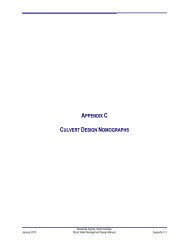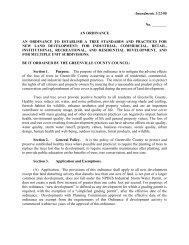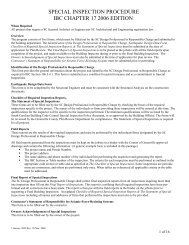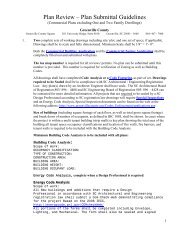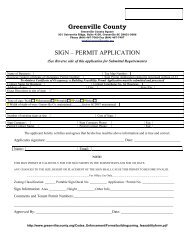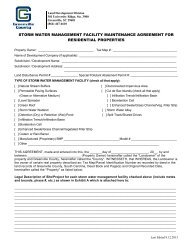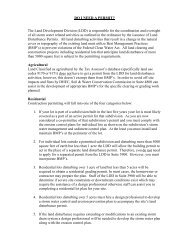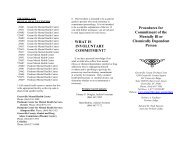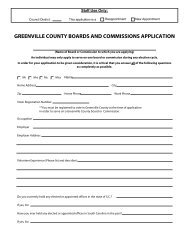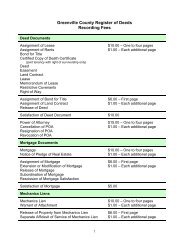Entire Design Manual - Greenville County
Entire Design Manual - Greenville County
Entire Design Manual - Greenville County
You also want an ePaper? Increase the reach of your titles
YUMPU automatically turns print PDFs into web optimized ePapers that Google loves.
consideration may need to be given to any planned future upstream land use changes. The analysis<br />
shall be performed in accordance with the requirements of this <strong>Design</strong> <strong>Manual</strong><br />
Watersheds that have well documented water quantity problems may have more stringent or<br />
modified design criteria determined form master plan studies by <strong>Greenville</strong> <strong>County</strong>.<br />
All storm water systems shall be designed to have no increase in velocity, peak flow, water surface<br />
level elevation in relationship to upstream, adjacent, and downstream property in the 100-year<br />
storm, unless an adequate permanent drainage easement is obtained.<br />
Water Quality Control<br />
All development and redevelopment projects and portions of redevelopment projects disturbing one acre<br />
or more or that will result in more than one cubic foot per second increase in peak runoff rates shall meet<br />
these requirements of this section even though there is not a change in land use.<br />
Water quality control is integral component of overall storm water management. All storm water runoff<br />
generated from a site shall be adequately treated before discharge. It will be presumed that a storm water<br />
management system complies with this requirement if the following minimum design criteria are met<br />
unless a waiver is granted on a case-by-case basis:<br />
1. The preferred method is to size permanent water quality capture devices to trap 85% of total<br />
suspended solids (TSS) based on annual loadings. An alternative as a default criteria, a device may<br />
be sized to capture the first inch of runoff from the impervious area of the site and discharge it over a<br />
twenty-four (24) hour period. and.<br />
2. The Director has discretion to require more stringent controls for water quality where the Director<br />
determines the minimum standards of this section are not adequate. Areas where more stringent<br />
controls may apply include outstanding resource waters, trout waters, wetlands, steep slopes,<br />
TMDLs or other sensitive areas.<br />
3. Appropriate structural storm water controls or non-structural practices are selected, designed,<br />
constructed or preserved, and maintained according to the specific criteria in this <strong>Manual</strong>.<br />
Any permanent water quality device shall be required to meet these requirements.<br />
When existing wetlands are intended to be water quality structures, the Storm Water Management<br />
Permit shall not be implemented until all necessary Federal and State permits have been obtained.<br />
General Storm Water Management Permit Submittal Items<br />
The following items are required to be included in the submittal package for a Storm Water Management<br />
Permit.<br />
Watershed delineation maps.<br />
Location of all storm water management structures.<br />
Pre- and post-development peak flow volumes, peak flow rates, peak flow velocities and inflow and<br />
outflow hydrographs of storm water runoff at all existing and proposed points of discharge from the<br />
site for the 2-, 10-, 25-, and 100-year 24-hour storm events.<br />
Site conditions around points of all surface discharge including vegetation and method of<br />
conveyance from the land disturbing activity.<br />
<strong>Greenville</strong> <strong>County</strong>, South Carolina<br />
January 2013 Storm Water Management <strong>Design</strong> <strong>Manual</strong> 3-12



